Acer V7-482PG-9884 Review: Everything You Need
by Jarred Walton on August 24, 2013 12:00 AM ESTAcer V7 Battery Life
So far we’ve looked at CPU and GPU performance metrics, but perhaps more important on any laptop is going to be battery life. Improving power use/battery life was one of Intel’s key goals with Haswell, and so far we’ve seen clear evidence of that in the Haswell laptops that we’ve reviewed. The Acer Aspire V7 confirms that trend, boasting some of the best (normalized) battery life figures that we’ve seen from a Windows laptop.
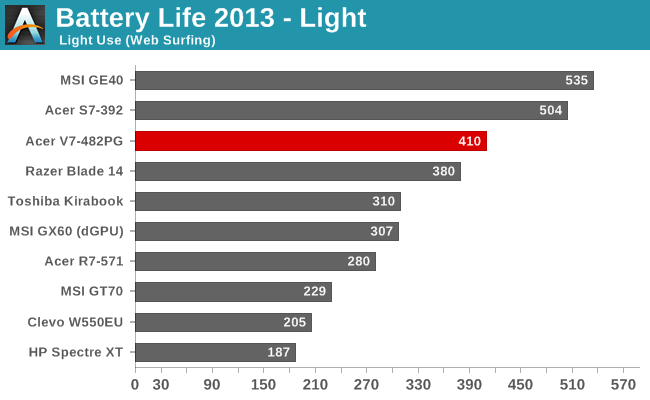
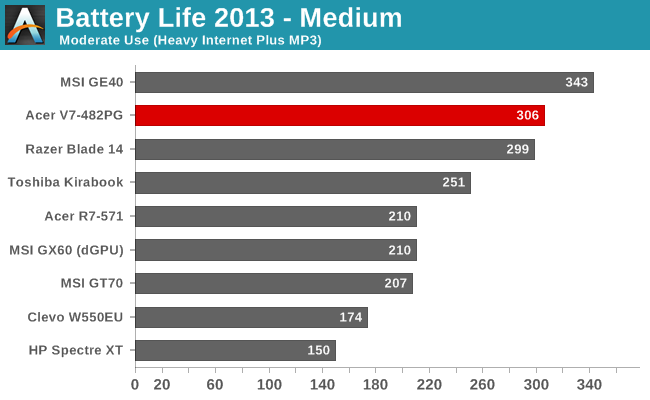
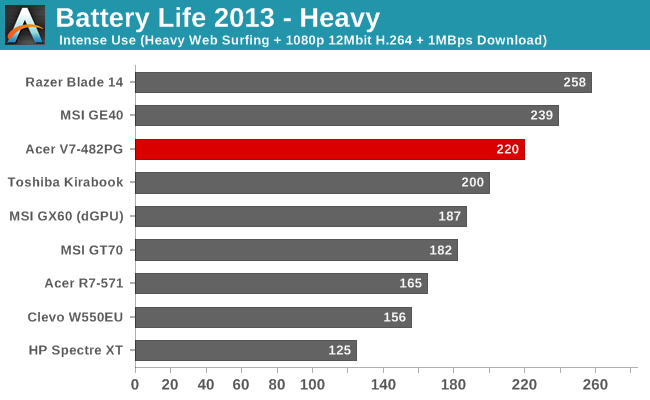
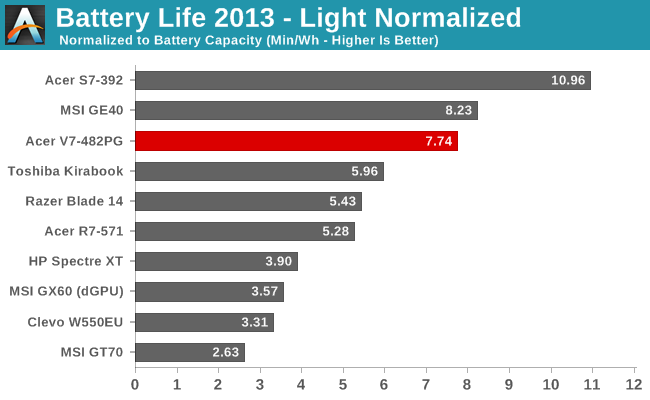
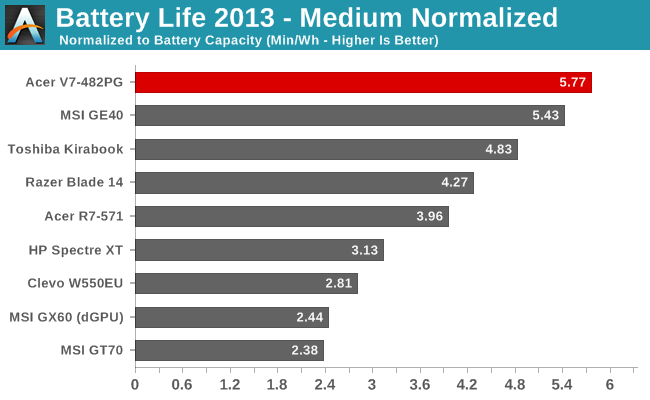
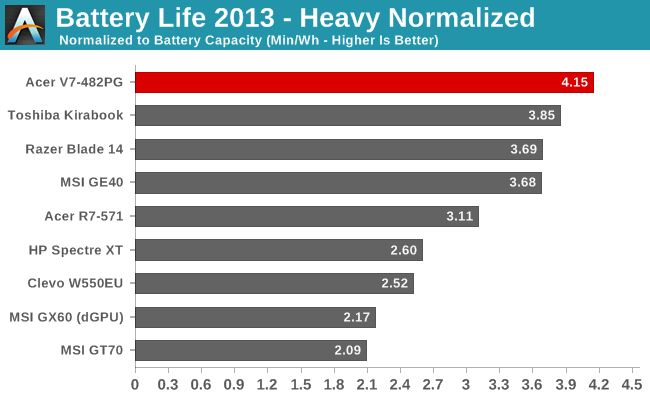
The 53.6 Wh battery isn’t the highest capacity battery you’ll find on market, but it’s the same capacity that Apple uses in the MacBook Air 13 (2013). What’s not the same is the battery life that you get with Windows compared to OS X. With Haswell, the Aspire V7 basically matches what Apple was able to do with the MacBook Air 13 (2012): around seven hours of battery life in our light workload. For reference, the new MBA13 delivered 11 hours in the same test. Still, the Haswell laptops are all posting significant gains over the previous generation Ivy Bridge laptops.
And thanks to NVIDIA’s Optimus Technology, even laptops with discrete GPUs like the MSI GE40 and Acer V7 don’t take a hit to battery life – at least when the GPU isn’t active. Power up the GPU and run a game, on the other hand, and the story changes quite a bit: we measured just 98 minutes of battery life looping 3DMark11 on the Acer V7 (with the GPU set to “prefer maximum performance” in the control panel and using the Balanced power profile). That might seem terrible, and it’s certainly not great, but higher performance GPUs are almost always throttled on battery power, regardless of what settings you use – the MSI GE40 delivered slightly less battery life in our simulated gaming test, with roughly the same performance as the Acer V7 under the same conditions. So basically, on battery power the GT 750M and GTX 760M aren’t all that different, despite the latter having twice as many shaders and substantially more memory bandwidth.
Getting back to the battery life aspect, the V7 posts good results certainly, but I was hoping for even a bit more from our first complete Haswell Ultrabook review. Perhaps the 14” touchscreen is part of the issue, as it could be sucking down precious milliwatts. Other components are also likely a factor, as the Acer S7-392 is quite close to the MBA13. Ultimately, we’re looking at average power draw for the entire laptop of around 7.7W in our Light test on the V7 compared to roughly 4.8W for the MBA13 in the same test under OS X; the S7 Haswell Ultrabook measured 5.4W, which is pretty close to the same sort of gap we’ve seen in the past. As for the V7, coming up with items to account for almost 3W is difficult.
I’m frequently amazed at how much better battery life is with Apple hardware under OS X. We’ve seen in the past that Apple usually optimizes (in a good way) quite heavily in their OS to achieve good battery life, and when you switch to Windows via Boot Camp you lose a lot of battery life. Anand didn’t test Windows battery life with the new MBA13, but I wonder what it’s like, because the usual 30% drop would put it on equal footing with something like the V7. I suspect with Haswell, the opportunities to further tune the OS and hardware for improved battery life are even greater, though, so we might see a 50% drop in battery life with the MBA13 under Windows.
If you need 10+ hours of battery life in Windows, it looks like you’ve got a couple options right now: get a system that’s not as fast (e.g. the V7 has a discrete GPU and hybrid storage with 12GB RAM while the S7 is iGPU only, pure SSD, and 8GB RAM), or find something with a higher capacity battery or a slice battery. For seven hours of useful work – and potentially eight or more if you turn the LCD brightness down a few more notches and don’t constantly surf the Internet – the V7 should be sufficient for most users.










62 Comments
View All Comments
damianrobertjones - Tuesday, August 27, 2013 - link
"I’m frequently amazed at how much better battery life is with Apple hardware under OS X" - I didn't see this in the last gen of macbooksI hope that this machine, as well as the Sony, is mentioned in future battery sections as the Mac DOES NOT PROVIDE the best battery life.
http://www.pcpro.co.uk/reviews/laptops/383785/dell...
JarredWalton - Tuesday, August 27, 2013 - link
Their "Light" battery test is not the same test that we use, nor is it at the same brightness setting. The MacBook Air 13 Haswell model gets 11.03 hours while loading four web pages every 60 seconds with the LCD at ~200 nits. They measured 12.68 hours of battery life doing what? "The light-use test is the absolute longest you can expect the battery to last with careful power management." That sounds like they're doing nothing, equivalent to our old "Idle" battery life testing from last year, and possibly at minimum brightness.We haven't been doing Idle testing for 2013, but on laptops tested previously idle battery life was typically 20% to as much as 40% more than what we got on our Internet testing. Our new Light test is our old Internet test with the LCD at 200 nits, so basically take the MBA13 result and multiply by at least 1.2 to be fair, and possibly as much as 1.4. That means the MBA13 under OS X while idle could easily hit 15+ hours, which would be more than any Windows laptop manages with a similar size battery.
Basically, you have to make sure you're comparing apples to apples when it comes to battery life testing. If a site doesn't completely document how they're testing, you can't do that.
willstay - Wednesday, August 28, 2013 - link
"Anand didn’t test Windows battery life with the new MBA13" - I wish he did. No one has done it with MBA13 yet.ihleonard - Saturday, August 31, 2013 - link
Since these don't seem to be available/on display in store anywhere, I want to get some idea of what they feel like before I take the plunge and get one. Are there any Acers (or other laptops) with a similar keyboard feel that are widely available in store; I just want to make sure that the low travel is ok.Thanks
Otunia - Monday, September 2, 2013 - link
This PC shows why 16:9 screens are bad. I'm writing this comment on an old 16:10 laptop which is as wide as this new Acer and guess? My screen is 15" thanks to all those extra vertical pixels.There are two extra downsides of this PC: the memory limit at 12 GB (why not two 8+8 GB unsoldered slots? For the extra thinness? Who cares!) and the glossy screen. So even if the keyboard and the touchpad turn to be super we are left with a subpar screen and constrained memory. The rotational disk would be OK if it can be upgraded later on.
A good attempt but please try again. Hint: just clone the 16:10 matte MBP 15" and perfect it by letting people upgrade its parts.
Hrel - Tuesday, September 3, 2013 - link
While I'm sure Microsoft is pushing for manufacturers to include touchscreens; it adds NO value right now. So the problem then becomes, if you include a touchscreen you can't charge for it. Which means reduced margins. I'm certainly not going to pay for it. This thing is at least $100 too expensive.Looks like a good machine though, if I could find it on sale for 1K I'd probably buy it.
ziotoo - Sunday, September 8, 2013 - link
Hey jared (or any v7 owner)My laptop died and thought of upgrading to the acer v7
The question is: i do design on my laptop, both 2d (photoshop, vectorial, animation, video editing) as well as 3d (from cad to maya/max). This is the first mainstream laptop i see with a decent dedicated graphic solution, and since i also do photo retouching you pretty much sold me on the screen. I travel a lot and the v7 is light and has the perfect screen format for me. It's also 1000eur in europe, wich is a really good price for this kind of product.
The problem is the i5 cpu. I've had a first gen i7 (i think 720 qm) quad core cpu for the past years and it was enough for me. But i'm scared that the acer v7 will actually offer worse performance with its 4th gen dual core i5 than my old laptop. Am i right to be worried? And would an i7 4500u actually be much better, even though that's also a dual core? It's gettong very hard to find quad core cpus in the 2kg weight range.
Thanks a lot.
ziotoo - Sunday, September 8, 2013 - link
Forgot to add: the 14 inch configuration in europe only sports an i5. The rest is unchangedhellermercer - Friday, November 22, 2013 - link
I need powerfull speakers!!!!hellermercer - Friday, November 22, 2013 - link
I need powerfull speakers!!!!